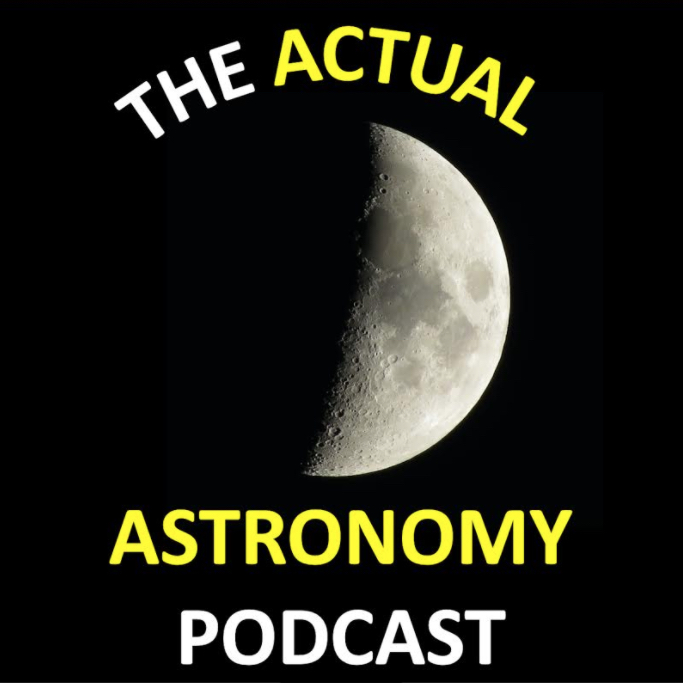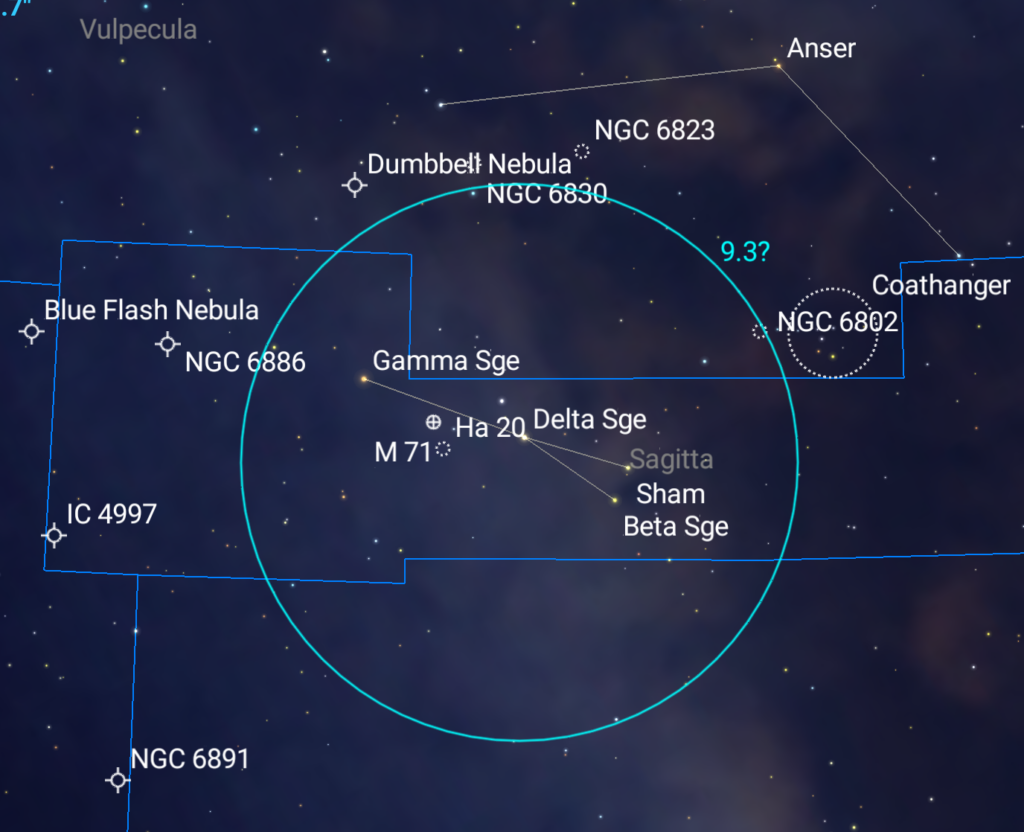Podcaster: Shane and Chris

Title: Episode 242 Observing in the Summer Toybox
Organization: Actual Astronomy
Link : https://actualastronomy.podbean.com/
Description: The Actual Astronomy Podcast presents Episode 242 Observing in the Summer Toybox. Have you ever heard of the Celestial Toybox Constellations? A long time ago I read an article about how the little constellations Vulpecula, Sagitta, Delphinus and Equuleus make up the Summer Toybox constellations because they are among the smallest recognized star patterns. What’s more each of these constellations will fit within wide field 7X35 binoculars many people might have laying around in a closet. We will explore the many star clusters, planetary nebulae and double stars as this region passes through the overhead on warm summer evenings.

Bio: Shane and Chris are amateur astronomers who enjoy teaching astronomy classes and performing outreach where they help the eyes of the public to telescope eyepieces.
Today’s sponsor: Big thanks to our Patreon supporters this month: Rob Leeson, David Bowes, Brett Duane, Benett Bolek, Mary Ann, Frank Frankovic, Michael Freedman, Kim Hay, Steven Emert, Frank Tippin, Rani Bush, Jako Danar, Joseph J. Biernat, Nik Whitehead, Michael W, Cherry Wood, Steve Nerlich, Steven Kluth, James K Wood, Katrina Ince, Phyllis Foster, Don Swartwout, Barbara Geier, Steven Jansen, Donald Immerwahr
Please consider sponsoring a day or two. Just click on the “Donate” button on the lower left side of this webpage, or contact us at signup@365daysofastronomy.org.
Please visit our Patreon page: https://www.patreon.com/365DaysOfAstronomy
or you can consider to sponsor a day of our podcast : https://cosmoquest.org/x/365daysofastronomy/product/sponsor-an-episode-of-365-days-of-astronomy/
Transcript:
Welcome to Episode 242 of the Actual Astronomy Podcast observing in the toybox constellations. I’m Chris and joining me is Shane. We are amateur astronomers who love looking up at the night sky and this podcast is for anyone who likes going out under the stars.
Have you ever heard of the Celestial Toybox Constellations Shane?
So a long time ago I read an online article about how all these little constellations Vulpecula, Sagitta, Delphinus and Equuleus were referred to as the Summer Toybox (sometimes Lyra is thrown in for it’s small stature) but it never caught on.
I loved that idea and what a perfect set to conquer several constellations in a short episode.
So we’ve talked about the Summer Triangle in the past, and most newcomers should get familiar with that asterism, but these little constellations form a line running perpendicular to the Milky-Way as they cut through the bottom quadrant of the Summer Triangle
At one time I went home for a visit and a friend of my Mother’s had given her a pair of old Sears binoculars. I hadn’t brought any optics with me on the trip so happy to have anything. To my surprise these things had like an 11-degree true field and while distorted on the edges you can fit many of the smaller constellations well framed within the better corrected portions of the field.
Starting at Alberio, the bottom star of the Cross of Cygnus and a beautiful colourful double we drop due south to the star 4.5 Magnitude Anser in Vulpecula, the Fox. In fact Anser used to represent it’s own constellation of a Goose depicted in the mouth of the fox…but alas it was eventually swallowed up by Vulpecula.
In 1967, the first pulsar, PSR B1919+21, was discovered in Vulpecula by Jocelyn Bell,
Vulpecula is mostly known as home to both the Coathanger “Cluster” and M27, the dumbbell nebula, but there are several other clusters here. And if you like Planetary Nebulae these constellations will prove to be about the richest hunting grounds. Let’s head a binocular field SE to Sagitta the Arrow.
Many binoculars will show the entire constellation, and I find it to be the most useful in the region since the shape is easily picked up naked eye from dark sites.
I use the quill stars on the back of the arrow as a point to the Coathanger and the front of the arrow to draw north from to land on M27.
But it has it’s own sites, M71 and Harvard 20 a barely discernible cluster in the same telescopic field.
We’ll pan another binocular field or so to the SE and centre on Delphinus, the dolphin
FOr unknown reasons the diamond pattern is called Job’s Coffin
The main constellations could be confused for the little dipper y beginners
Laying in a rich Milky Way star field means Deliphinus is ripe for deep sky picking with modest scopes.NGC 6891 is a planetary nebula of magnitude 10.5; NGC 6905 is the Blue Flash nebula. NGC 6934, a globular cluster of magnitude 9.75. At a distance of about 185,000 light-years, the globular cluster NGC 7006 is 11.5 magnitude and at the farthest reaches of our Milky-Way galaxy.
Well you have to end somewhere and Little faint Equuleus the little horse is the end of our road
As the second smallest constellation it’s tiny indeed
Due to its small size and its distance from the plane of the Milky Way, Equuleus contains no notable deep sky objects. Some very faint galaxies between magnitudes 13 and 15 include NGC 7015, NGC 7040, NGC 7045 and NGC 7046.
Equuleus contains some double stars of interest. γ Equ consists of a primary star with a magnitude around 4.7 (slightly variable) and a secondary star of magnitude 11.6, separated by 2 arcseconds. Epsilon Equulei is a triple star also designated 1 Equulei. The system, 197 light-years away, has a primary of magnitude 5.4 that is itself a binary star; its components are of magnitude 6.0 and 6.3 and have a period of 101 years. The secondary is of magnitude 7.4 and is visible in small telescopes. The components of the primary are becoming closer together and is a difficult split in amateur telescopes.
Thanks Shane and to everyone for listening, be sure to subscribe and we’re always excited to get observing emails to actualastronomy@gmail.com.
End of podcast:
365 Days of Astronomy
=====================
The 365 Days of Astronomy Podcast is produced by Planetary Science Institute. Audio post-production by Richard Drumm. Bandwidth donated by libsyn.com and wizzard media. You may reproduce and distribute this audio for non-commercial purposes.
This show is made possible thanks to the generous donations of people like you! Please consider supporting to our show on Patreon.com/365DaysofAstronomy and get access to bonus content.

